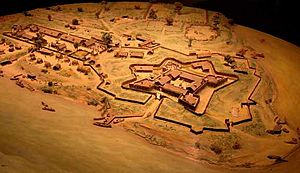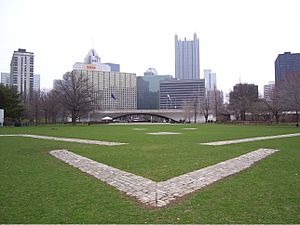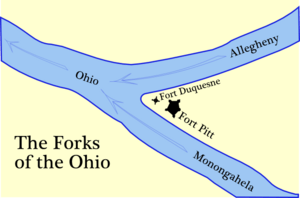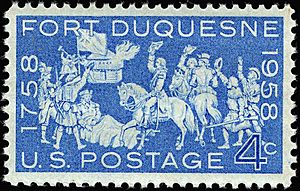Fort Duquesne facts for kids
Quick facts for kids Fort Duquesne |
|
|---|---|
| Pittsburgh, Pennsylvania | |
 |
|
| Type | Fort |
| Site information | |
| Controlled by | |
| Site history | |
| Built | 1754 |
| In use | 1754–1758 |
| Battles/wars | French and Indian War |
Fort Duquesne was a fort built by the French in 1754. It was located where the Allegheny and Monongahela rivers meet. This spot is now Pittsburgh in Pennsylvania, USA. The French later destroyed the fort. This happened before the English could capture it during the French and Indian War. The English then built Fort Pitt in its place. Today, the area where both forts stood is Point State Park. You can see the outlines of the old forts marked with bricks there.
Why Fort Duquesne Was Important
Fort Duquesne was built at a very important spot. This is where the Allegheny and Monongahela rivers join to form the Ohio River. This area was key for controlling the "Ohio Country." It was important for both new settlements and for trading.
An English trader named William Trent had a successful trading post here. He traded with many nearby Native American villages. Both the French and the British wanted to control this valuable area.
The French believed this land was theirs. It was part of the Mississippi River basin, which they claimed. They already controlled New France (Canada) and areas along the Mississippi River.
In the early 1750s, the French started building a line of forts. These included Fort Presque Isle near Lake Erie and Fort Le Boeuf in Pennsylvania. They also built Fort Machault on the Allegheny River.
Robert Dinwiddie was the leader of the Virginia Colony. He thought these French forts were a threat to Virginia's land claims. In 1753, he sent a young officer named George Washington. Washington was to deliver a letter to the French commander at Fort Le Boeuf. The letter asked the French to leave. Washington also needed to find out how strong the French were. The French politely refused Washington's request.
Building and Losing the Fort
After Washington returned, Virginia sent people to build a small fort. It was called Fort Prince George at the Forks of the Ohio. Work started in February 1754. But in April, a much larger French force arrived. They were led by Claude-Pierre Pécaudy de Contrecœur. The French made the small British group surrender.
The French then tore down the British fort. They built Fort Duquesne in its place. It was named after Marquis Duquesne, the governor of New France. This new fort was similar to Fort Frontenac on Lake Ontario.
Meanwhile, George Washington was promoted to Colonel. He set out with a small group to build a road and defend Fort Prince George. He heard the fort had surrendered. On May 25, Washington took command of his group. Two days later, he met a French scouting party. This happened near a place now called Battle of Jumonville Glen. Washington attacked the French Canadians. Ten were killed, and 21 were captured.
This fight at Jumonville Glen is often seen as the start of the French and Indian War. This war was part of a bigger war called the Seven Years' War.
Washington then built Fort Necessity. It was in a large open area called the Great Meadows. On July 3, 1754, the French and Canadians attacked. They forced Washington to surrender Fort Necessity. After taking their weapons, the French let Washington and his men go home.
Fort Duquesne's location looked good on a map. It controlled where three rivers met. But in reality, the spot was low and often flooded. Also, higher land across the Monongahela River overlooked the fort. This meant an enemy could easily attack it with cannons.
The French held the fort successfully early in the war. In 1755, they stopped an English attack. This was the Braddock Expedition led by General Edward Braddock. George Washington was one of Braddock's helpers.
A smaller attack by James Grant in September 1758 was also pushed back. But two months later, on November 25, the Forbes Expedition arrived. This larger British force was led by General John Forbes. The French destroyed Fort Duquesne themselves and left the site. The British then took control.
Today's Site

Fort Duquesne was built at the very tip of land where the Allegheny and Monongahela rivers meet. This area is now Point State Park in downtown Pittsburgh. The park has brick outlines showing where the fort's walls once stood. It also shows the outlines of the later Fort Pitt.
In 2007, an archaeologist named Thomas Kutys found a stone and brick drain at the site. It is believed to have been part of one of the fort's buildings. This drain might be the only part of the original fort that still exists. Much of the northern part of the fort site was destroyed by factories in the 1800s.
Remembering Fort Duquesne
On November 25, 1958, the U.S. Post Office released a special stamp. It marked 200 years since Fort Duquesne was captured. The stamp shows Colonel Washington on horseback. General Forbes, who was sick, is shown lying on a stretcher. Colonel Henry Bouquet and other soldiers are also on the stamp.
Fort Duquesne in Stories
- Old Fort Duquesne, or, Captain Jack, the Scout is a historical novel. It tells the story of events at Fort Duquesne during the French and Indian War.
- Fort Duquesne appears in the TV show Timeless.
- The fort is also in the video game Assassin's Creed III. In the game, it looks different from the real fort. It is still called Fort Duquesne even after the British rebuilt it. It is one of the main forts the character Connor has to capture.
See also
 In Spanish: Fort Duquesne para niños
In Spanish: Fort Duquesne para niños





